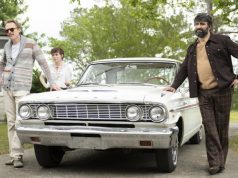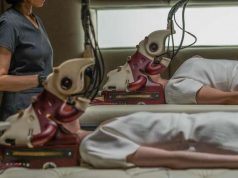Nothing that happens in “Escape from Tomorrow” is half as intriguing as what happened behind the scenes. That’s not for lack of trying, mind you — what happens onscreen is pretty weird, too — but it’s hard to top the bizarre journey that first-time filmmaker Randy Moore had in getting his work into theaters.
“Escape from Tomorrow” is about a man losing his mind while on vacation with his wife and children at Disney World. Moore shot the film guerrilla-style at Disney World and Disneyland without even trying to get permission from the Disney company, which doesn’t allow outside productions to shoot in the parks, especially not productions that make a mockery of the squeaky-clean image. Moore, his actors, and his crew had to keep a low profile, shooting surreptitiously for a few minutes at a time to avoid attracting attention. If nothing else, the movie is a marvel of logistics and planning.
It was a hot ticket when it premiered at Sundance last January, mostly because everyone thought they’d never get another chance to see it. The pervading belief was that Disney would sue it out of existence (the company is not usually shy about defending its intellectual property). Some experts argued that the film qualified as satire and would be protected under the First Amendment, but they also acknowledged that a victory in court would take years.
But lo and behold, Disney has taken the opposite approach: total silence. Rather than stomp into the valley and fight David, Goliath has chosen to ignore him. And so here is “Escape from Tomorrow” (with the obligatory “Disney had nothing to do with this movie” disclaimer at the beginning) in theaters and VOD, out there for all the world to see. We live in an age of miracles!
It’s a shame the movie isn’t as good as its backstory.
Disregarding the unusual circumstances under which it was made, it’s a barely passable, surrealistic dark comedy that starts with Jim (Roy Abrahmsohn), on the morning of his family’s last day at Disney World, learning he has lost his job. He doesn’t tell his wife (Elena Schuber) or their kids; instead he sublimates the bad news and starts to go a little bonkers. He gazes lustfully at a pair of jail-bait teenage girls. He hallucinates on It’s a Small World, seeing demonic faces on the angelic dolls. He learns that something called “cat flu” has been going around. As the day progresses, Jim learns more disturbing things about the park.
Contrary to what you might expect, the film doesn’t really take satiric aim at Disney specifically, but is instead a jaundiced view of the idealized American family vacation. The Disney parks typify that ideal, of course, but whatever pointed criticism there was of Disney’s corporate takeover of children’s imaginations has been excised from the film’s final cut. The first 20 minutes are titillating because we see a lot of footage shot inside the Disney rides, which we instinctively know is taboo. Once the novelty wears off, though, we’re faced with subpar acting (even if we allow for the difficulty in capturing performances shot on the fly) and a not-quite-coherent story.
Then again, it’s impossible to watch the movie without thinking about its origins, and those origins make it a fascinating artifact. It’s estimated that 70 percent of Americans have been to a Disney theme park at least once in their lives; that number is probably even higher among “Escape from Tomorrow” audience members. So even if it’s not great as a movie, it’s intriguing as a reflection of an experience familiar to most viewers.
B- (1 hr., 30 min.; )
Originally published at About.com.
I wrote something about this film during Sundance, too: "The Thrill of Sneaking Around Under Mickey Mouse's Nose."





